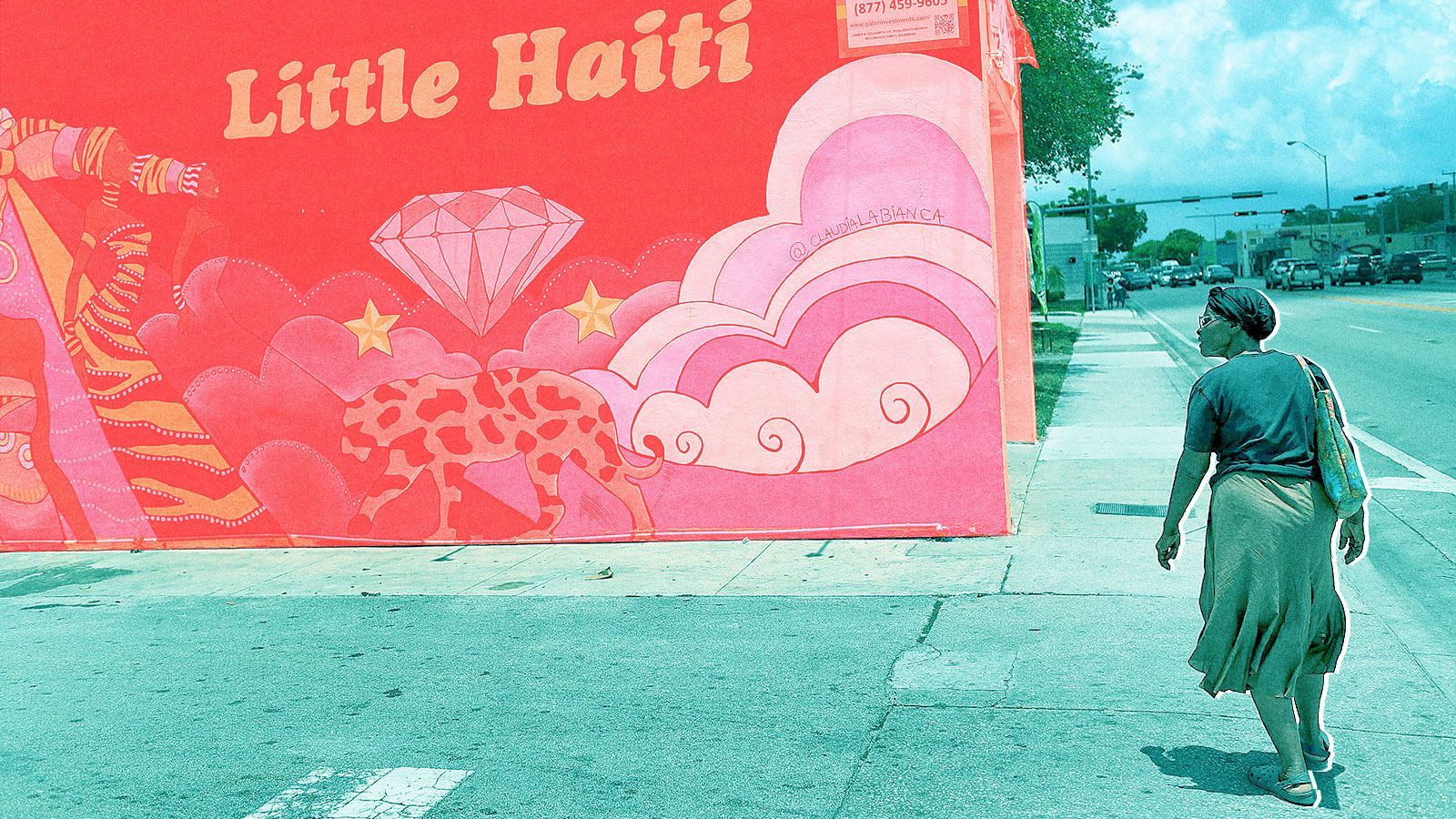The neighborhood came to be known as Little Haiti. Though Miamians made it plain that Haitians weren’t welcome elsewhere in the city, here within the boundaries of Lemon City, the Haitians had a community. “It scared people, even people who claimed to be open and not racist,” says Marleine Bastien, executive director of Family Action Network Movement, formerly the Haitian Women of Miami. “The Miami Herald would write about the Haitians coming here and taking our jobs,” says Bastien, who immigrated from Haiti in 1981 when she was 22.
Haitians began buying property and opening businesses, shops and restaurants in the neighborhood. Over time, the economy slowly began to pick up, and little by little the community created change. So while the area remained economically disadvantaged, it was also warm and vibrant, the air filled with the smells, sounds, colors, and culture of kreyòl ayisyen, or Haitian Creole.
Now the same sea that brought Haitians to America is fueling a second displacement.
As sea level rise increasingly threatens lowland and coastal areas, South Florida real estate developers and prospectors have set their sights higher and further inland, on places like Little Haiti. In a phenomenon known as climate gentrification, the community is being pushed out as wealthy Floridians move in, to get away from areas more vulnerable to storms and rising seas. Recently, the gentrification of Little Haiti has been accelerated by a federal tax break that incentivizes development in what are called Opportunity Zones — poor, typically minority-majority communities like theirs.
Today the neighborhood is being sold off, carved apart, and built up, taking the Haitian community and regional cultural identity with it. But local advocates are fighting back by pressuring city officials and influencing development.
Change is in the Air
For Haitian immigrants like Uhuru Konsyan, Little Haiti, or Ti Ayiti, is a place to reconnect with their place in the world.
Konsyan, who founded a local construction company called Konscious Kontractors after Hurricane Irma three years ago, immigrated from Haiti to the United States with his family as a child. Now 34, Konsyan, who was raised in nearby Broward County, finds that Little Haiti helps remind him who he is.
“Without that identity, I think I don’t have that full-on confidence to survive within the American society and to be a better citizen,” he says.
Over time, Little Haiti became an accepted part of Miami’s diverse culture. For years, it was the largest community of Haitian ex-patriots in the world. Even though that distinction has been overtaken by Brooklyn, New York in recent years, Florida’s Haitian population still outnumbers that of other states. In 2016, the city officially approved renaming the neighborhood Little Haiti. This victory was many years in the making.
By the time this took effect, things had already started to change; Little Haiti was losing some of its local flavor. Lured by opportunity elsewhere, Haitians had been trickling out of the neighborhood for a while.
Some simply moved away or went to college, never to return. Others’ homes were seized by the city. Bastien says that 20 years ago, Miami began fining Haitian property owners for code violations. In 1998 the Miami New Times reported that a new code enforcer in the area was cracking down on violations such as unauthorized multiple units on the same parcel. At the time, there were at least 1,300 violations backlogged, some from as far back as 1991. The city’s effort to “clean up” certain areas continues today.
At the time, many people didn’t realize how serious the fines were and that they would increase if unpaid, Bastien says. Nor did anyone realize how many people were affected. Bastien estimates that up to a third of Little Haiti’s homeowners lost their properties as a result.
On the heels of the property seizures, other changes soon began. Developers who’d long been content to keep their cranes and bulldozers busy in other parts of the city began gobbling up property. Gentrification was beginning. Today Little Haiti is one of the fastest-gentrifying communities in the country.
Miamians know what gentrification can do to a neighborhood; just south of Little Haiti, the working-class Puerto Rican barrio of Little San Juan has been thoroughly gentrified. The property price per square foot in some locations increased ten- to twentyfold in a decade. Today, even its name is different: The neighborhood is now known as the Wynwood Arts District.
By the mid-2010s, it was clear that Little Haiti was next.
A Perfect Storm
It’s easy to understand why Little Haiti is attractive to developers. The neighborhood enjoys close proximity to the beaches, downtown, and two major airports; its real estate supply is high, and costs are relatively low.
According to Zillow, the median price per square foot in Miami is $420; in neighboring Key Biscayne it’s more than $700. Little Haiti’s median price per square foot is $330, though it’s rising, and fast. Last year alone, Zillow reports that the average price rose 5.3 percent; this year it predicts a 4-percent increase.
Rising costs are pushing more longtime residents out of Little Haiti. Some have seen their rent double or triple in a single year; many who own property have cashed in on their equity. Haitians are being displaced to neighboring communities like Homestead, North Miami, and Miami Lakes, unable to return because they’re priced out of the market in Little Haiti. “They want to come back and purchase, but guess what, they can’t afford it,” Konsyan says.
Last June, the Miami Herald reported that while Miami’s Black and Black-Hispanic population increased by 2 percent from 2010 to 2018, in that time frame, neighboring Broward County, where property is significantly cheaper, saw the same groups increase by 100,000 individuals, or 22 percent.
When gentrification began, residents were unaware that this demand was being driven by another, much larger force: climate change.
More than a decade ago, frustrated by the federal government’s unwillingness to plan for climate change, Miami-Dade County joined Broward, Monroe, and Palm Beach Counties to develop strategies to address its coming effects, including sea level rise, increasing temperatures, and more intense storms.
In 2010, they released the Southeast Florida Regional Climate Change Compact, the first regional climate change adaptation and mitigation plan of its kind. The plan identified reduction and mitigation strategies as well as vulnerabilities, such as what areas would be affected by one-, two-, and three-foot sea level rise. Just one foot of sea level rise will inundate 12 percent of land in Miami-Dade, and three feet will inundate 18 percent.
Little Haiti, on the other hand, is among the areas most resilient to sea level rise in the city of Miami. With an average height of 13 feet above sea level, and some areas as high as 32 feet above, it’s one of the highest points in the city. Among prospective property buyers 30, even 20, years ago, the threat of rising seas ranked well below other concerns, like proximity to the beach or downtown. Today it’s on the forefront of the minds of many people in South Florida, an area that is one of the most vulnerable to sea level rise. Considering that, as compared to 1992 base levels, the compact predicts seas will rise up to 10 inches by 2030, 2 feet by 2060, and 5 feet by 2100, Little Haiti becomes even more attractive, particularly to large-scale developers that plan years or even decades ahead.
Gentrification was already underway by the time people in Little Haiti found out it was at least partially fueled by climate change. “The privileged and powerful, they make plans,” Bastien says. “As usual, we Black and browns, we are the last to know.”
Now they’re losing even more ground. Three years ago, a temporary federal tax break for development in Opportunity Zones greatly accelerated the urgency for moneyed interests to buy in Little Haiti and other communities like it nationwide. Under the tax break, developers can defer paying capital gains taxes until 2026; the tax break can become permanent if they keep the property for 10 years or reinvest profits in Opportunity Zones Funds.
To qualify as an Opportunity Zone, the area must have either a 20 percent or greater poverty rate or a median income no greater than 80 percent of the metro area. Municipalities nationwide scrambled to apply. Little Haiti easily qualified to be among the 67 areas in Miami that were approved. This set the stage for more, and bigger development.
“There’s a lot of development going on that isn’t with the character of the neighborhood,” says Adrian Madriz, who works with Miami Workers Center and is the executive director of Struggle for Miami’s Affordable and Sustainable Housing (SMASH).
Some have criticized Opportunity Zones for essentially enabling rich developers to get richer displacing the poor without providing them anywhere to live or work. Madriz points out that there are no strings on the tax break, such as building a certain amount of affordable housing, hiring from within the neighborhood, or consulting local residents, and says that the minimum investment requirement is too high for residents.
Konsyan agrees: “We don’t have the means to benefit from the Opportunity Zones.”
Yet the federal government claims the zones will benefit the people who live there, and cities like Miami are going along with it.
Only money stands in the way of the people of Little Haiti taking advantage of Opportunity Zones. Although the area is statistically less affluent, it is possible for residents to pool together or seek outside funding. They can also find creative ways to work with developers to try to influence the process. They can also continue to pressure city officials.
An Uphill Battle
Little Haiti isn’t going down without a fight. Residents have organized and are actively trying to seize the reins before their community is lost.
Last year, in spite of passionate opposition from many across Little Haiti, the city approved the controversial Magic City Innovation District that will redevelop 18 acres in an area comprising mostly one- and two-story residences into a glitzy mixed-use development, with permission to build as high as 25 stories tall. “We have a lot of residential communities that don’t necessarily need these high rises,” Konsyan says. “Ti Ayiti is one of them.”
In exchange for the zoning changes, Magic City developers put $31 million in a fund to build affordable housing elsewhere in Little Haiti. Some felt that $31 million was a fair compromise, and that the changes coming to the neighborhood are inevitable, so it’s better for locals to negotiate for some benefit than fight to the last and get nothing. Leonie Hermantin of Concerned Leaders of Little Haiti, which supported the project, told the Associated Press, “It is better to work with them and ensure our stability and hope they will be a major contributor to the financial growth and well-being of the residents of Little Haiti.”
Bastien is among those who disagree. “When you look at the breadth, the scope, the density of this mega-million project, $31 million is nothing,” she says.
Other large-scale developments are in the works. Thanks to Miami zoning code that allows developers who hold nine contiguous parcels to propose a zoning variance for the property that drastically differs from the rest of the neighborhood, and a relatively amenable city government, there may be nothing advocates for Little Haiti can do to stop the next Magic City.
More recently, such advocates were cheered when the Planning, Zoning & Appeals Board refused to vote on the proposed Eastside Ridge project, a zoning variance that would transform 22 acres of Little Haiti into a mixed-use development. Its refusal to vote amounts to a pocket veto, as even a vote of no sends the proposal to the full city commission, which, like most, is historically unlikely to vote against wealthy developers.
The Eastside Ridge developer has filed suit. Miami code requires the zoning board to vote in a “reasonable” time frame, but residents are hoping they can stall long enough to change the zoning code and implement a zoning overlay for the neighborhood before climate gentrification causes Little Haiti to lose its identity entirely.
Bastien says, “This is a fight for our very existence that’s going on right now.”
Marguerite Casey Foundation nurtures a movement of low-income families advocating on their own behalf for change. The Foundation supports families strengthening their voice and mobilizing their communities to achieve a more just and equitable society for all.




